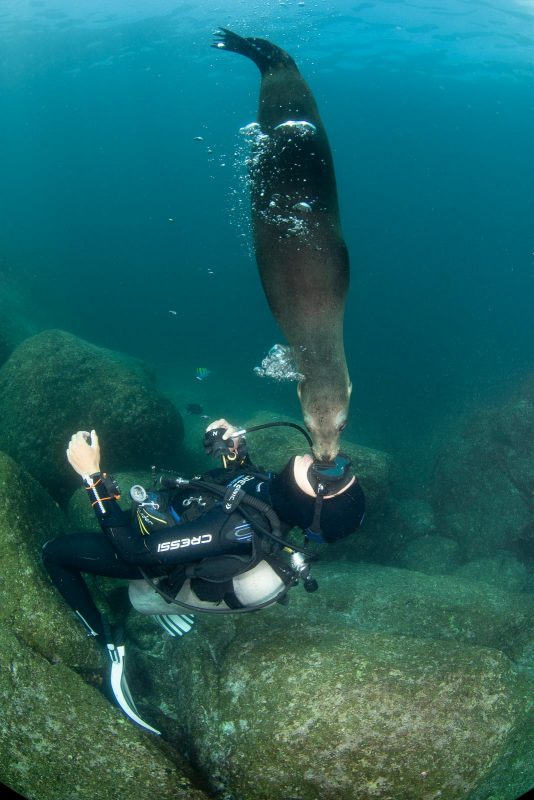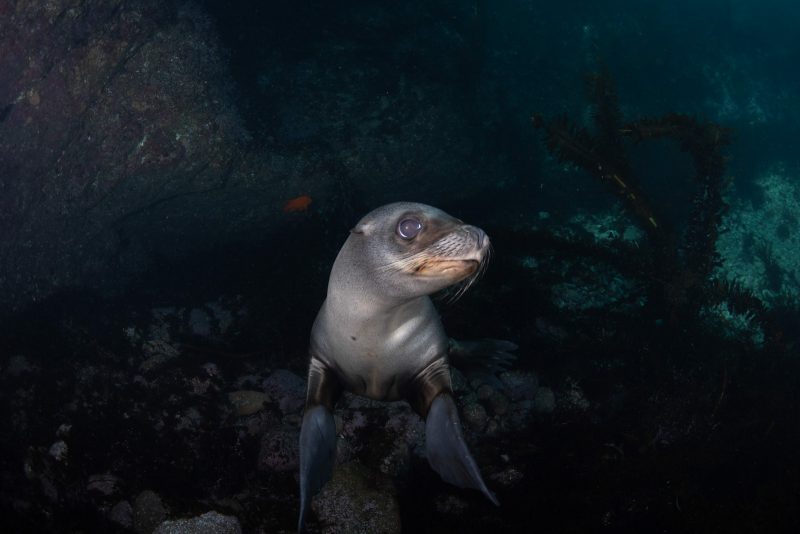How to Photograph Sea Lions

There is one marine mammal that everybody loves, and that’s a sea lion. With those big brown eyes, huge fanning whiskers and crazy antics, they are a loveable creature.
I think they are loved so much because they remind us of our four-legged family members, and who doesn’t love to take pictures of their family pet’s antics? Under the water, it seems that this marine mammal’s sole purpose is to play – and it’s a given you would want to take its picture.


In this article, we’ll look at how to photograph sea lions.
Sea lion behaviour
Sea lions seem to always be playing – whether that’s with another sea lion, chewing and biting each other, or just entertaining themselves with a starfish or rock. When they’re not in the water, you usually can find them sunning themselves on a rock or pier, warming up for the next round of activity.
Sea lions tend to love to play with humans: zipping past you as fast as they can, chewing on your fins, sitting above you while you exhale bubbles, and swishing those bubbles in their lips. They’ll even pick up objects like rocks, starfish or kelp leaves, dropping them or spitting them out at you. They’ll wait for you to throw the item back so that they can retrieve them and start a game of fetch. They really are just big puppy dogs wanting to constantly play.
What time of year to photograph sea lions
Sea lions can be photographed pretty much all year, but there are some better times to enjoy them.
The male bulls are typically not friendly and it’s best to not really engage the sea lions during breeding season – around May through to June. During this time, the males get very territorial and have been known to charge and bump humans who get too close.
During the other 10 months of the year, the sea lions are fun and engaging. However, I think the best time is when the baby sea lions have reached what is equivalent to our teenage years. These pranksters can usually be found around October/November time.
There’s nothing like having 100 teenage sea lion pups dive-bombing you with one sole purpose: to play with the human that has decided to come in to their playground.
At this age, they are extra playful and engaging. It’s especially funny to see the assigned adult babysitter try to corral them all and make them move on. You’ll have a moment where they’ve all left and then – bam – they’re back again, ready to tug on your fins. You can almost see the babysitter’s eyes roll wondering how they got that job.
How to photograph sea lions
The best thing about sea lions is that you can move to the vicinity of where they’re at, plant yourself in a spot and they will generally come to you.
My buddy uses a tripod underwater and the legs squeak, which seems to be a dinner bell for them to come play. He’s ahead of the rest of us. But, generally, they will come and hang out with you if you wait.
They do get bored easily, so try doing a few spins or wiggles underwater to keep their attention. With the young pups, though, it seems that it doesn’t take much to keep their attention focused on you.
Camera settings
Sea lions are very fast and tend to zip, fly, and zoom past you – so you’ll want to have your settings set to a faster shutter speed. I’d say a minimum of 1/250th is needed to catch them.
Your f-stop and ISO speed will largely depend on how deep you are. At a shallow 15-20ft, you can get away with f/8-11 and ISO 250, but at greater depths (around 50ft) you will have to open up that f-stop sometimes to f/5.6 or larger. You’ll also need to bump up your ISO to 800 or more.
Strobes
Your strobe setup will also be largely dependent on your depth. Sea lions like to drop down in the sand, roll around, and get the water all dusty – so it may be that you will need to shut off your strobes to cut down on the backscatter.
This is fine, because you can get creative by converting the shot to black and white if it’s deep or using the ambient light to showcase them if it’s shallow.
If you get lucky and you don’t have a sandy bottom, strobes are great at lighting up their faces and whisker details. Be sure to turn them up because most sea lions are dark and will absorb all the light.
You’ll want to point the strobes straight ahead so that they are at the same distance from the camera housing that the subject is from the front of your lens. This will help that inner part of the cone of light “kiss” the sea lion’s face.
Read more: What Equipment Do You Need for Underwater Photography?
Photographing them is easy and because they’re always moving. Just shoot, shoot, shoot. Because they are fast, you need to have your settings dialed in before you start taking pictures.
I’ve learned that you should never put your camera rig down because the minute you do that, an epic pose happens right in front of you. By then bringing up your camera to take the shot, it spooks them and you lose your opportunity. Even though they are fast, many times they will stop right in front of you, strike a pose, and just look at you.
Ultimately, with sea lions it’s best to just pick a spot and plan on planting yourself for a bit and watch their behaviour. Then, when you have seen what they’re doing, you can move around or stay where you’re at and just start clicking.
Remember that even though your camera shutter can take a lot of photos, you’ll need to know your strobe’s sync speed – which is usually 1/200th to 1/250th. If you just keep hitting your shutter, you’ll have a correctly lit shot and then several dark shots until the strobe recycles and is able to fire off another round.
Best places to swim and photograph sea lions
There are many places to hang out with sea lions. However, the best location that has the most opportunities to find them is off the west coast of North America, from British Columbia all the way down to La Paz, Mexico. Here sea lion colonies are established up and down the coast.
British Columbia you will get the bigger stellar sea lions that want to come play with you. Monterey in California has a jetty where, at the end, a sea lion colony hangs out 365 days a year. There is an easy beach entry to swim to the end where over 200 are always playing.
Santa Barbara Island, off the Channel Islands, has several colonies and the pups get very playful and the water is sometimes very shallow. I just recently did a trip to the Coronado Islands, just across the border in Mexico, from San Diego and this was a treat. The water was a clear blue and the sea lions very shallow.
Finally, one of the highlights of La Paz, Mexico, is a trip out to Isla Los Islotes where there’s a resident colony that is there all year and are extremely friendly towards humans.
In conclusion
If you haven’t had the pleasure of diving with sea lions, it is something you definitely need to add to your bucket list.
There’s always something new, too. I’ve been diving with them for over 15 years and I still have them perform a new behaviour that I’ve never seen before. This past year I had one pup grab a kelp leaf, throw it up in the water column and then grab it. I ended up getting a leaf, swinging it around, and then threw it at the pup; it retrieved it and brought it back to me.
I also had one sit above me while I was doing my safety stop after diving the oil rigs off of Long Beach, CA, and it spent over 20 minutes gulping my bubbles as I exhaled. You can bet that I was purging my regulator to make more bubbles!
It’s a never-ending experience diving with these underwater puppy dogs and, once you dive with them, you’ll be trying to figure out the next time you can do it again.













